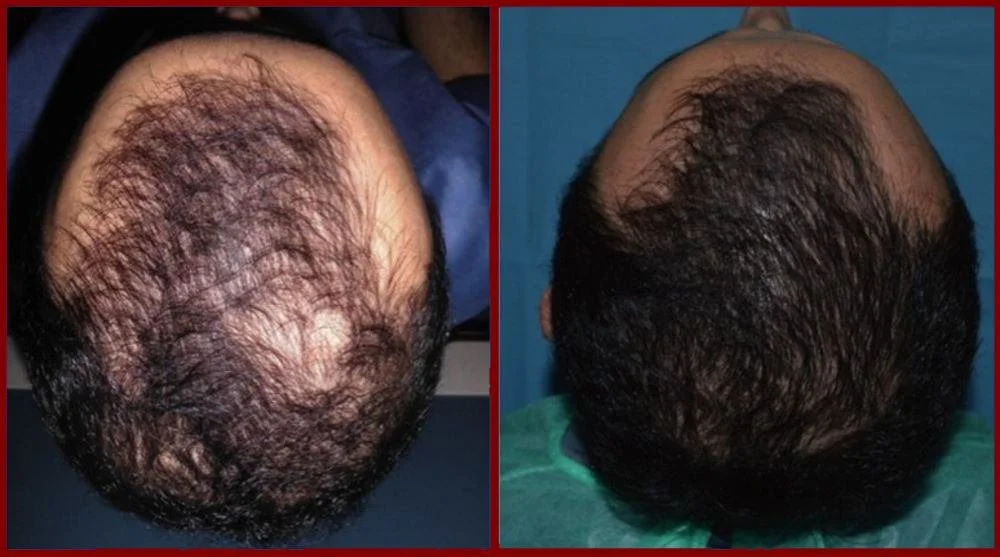PRP Hair Restoration:
Achieve natural, thicker, and fuller hair
Statistics: About 50 million American men and 30 million women have male- or female-pattern baldness. It can begin early in life, but is much more common after the age of 50, when more than 50% of men will experience some kind of hair loss.
However, an emerging treatment — platelet-rich plasma (PRP) therapy — help regrow lost hair. And, there are virtually no side effects from PRP, except for a mild feeling of pressure at the injection
How does PRP therapy compare with other options?
There are two FDA-approved medications for treating hair loss: Finasteride and Minoxidil. But you must take these drugs consistently over time and results are inconsistent.
Each drug also sometimes has side effects:
Minoxidil may cause dryness and itching on the scalp.
Finasteride may cause sexual dysfunction in men.
Hair transplantation is another option, but it requires cuts in the scalp and recovery time is longer. Because it is a surgical procedure, doctors typically recommend hair transplantation only for those who have dramatic hair loss.
PRP Hair restoration photos
Possible Causes:
Genetic
Restricts follicle growth space
Reduce oxygen and nutrition supply
Treatments:
PRP
Microneedling
Botox
Dr. Hong Signature Scalp treatment
Hair loss is a serious cosmetic issue for a lot of people, both men and women. Not only does it drastically impact your confidence, but hair loss can also make you appear older than you really are. If you have considered treatment for your hair loss, Platelet-rich plasma (PRP) therapy and Microneedling should be your first treatment option. Dr. Hong uses this non-invasive procedure for both men and women, and the results are truly amazing.
What is Platelet Rich Plasma for hair restoration?
Platelet Rich Plasma or PRP is an exciting non-surgical therapeutic option for both men and women who require stimulation of hair growth for hair loss conditions. PRP contains essential and specific growth factors that assist in hair regeneration.
What is the process for PRP for hair restoration?
Blood is drawn and specially prepared using the Eclipse centrifuge technology. The Dr. Hong PRP method is the medical industry’s gold standard for harvesting the most viable and abundant protein-rich cells.
PRP Hair Restoration therapy works by separating the protein-rich cells in your blood and then injecting into the areas of hair loss or hair thinning.
Is PRP painful for hair restoration?
Topical anesthesia is applied to the treatment area, so the entire procedure will be comfortable. Then, a microneedle is performed to create small channels to stimulate the dermis in the treatment area(s) of the scalp. The highly concentrated PRP is then injected into the treatment site and applied topically for maximum results.
How does PRP work for hair restoration?
The enriched cells contain cytokines and powerful growth factors that have been proven to stimulate natural hair growth and follicle function. The number of treatments is directly related to the cause of hair loss and the significance of hair loss. The most common area for treatment is the scalp, but other areas of the body are candidates for treatments.
Who is a candidate for PRP for hair restoration?
Both men and women are candidates for PRP Hair Restoration and those with patches of weak-quality of hair growth or patches of alopecia areata. Results vary, but in general, you will begin to see new hair growth within three to six months. PRP is not a cure for hair loss. It will slow hair loss and stimulate dormant follicles. It is recommended to continue PRP treatments and medical microneedle treatments to maintain results of hair regrowth and thicker, fuller hair. PRP therapy is known as a revolutionary way to stimulate and restore hair growth, as well as one of the safest cosmetic hair growth options on the market today.
Researchers see promising results
Scientific studies recently published discuss the PRP hair restoration technique. They prove it is an all-natural, safe, and non-invasive procedure that has been found to stimulate the growth of hair and to reduce the effects of thinning. According to a study published in Dermatologic Surgery, Italian physicians successfully used PRP in a clinical trial.
Dr. Hong’s PRP
Dr. Hong’s platelet-rich plasma therapy is designed to help you restore your hair long-term naturally, without surgery or chemicals. Not all PRP hair restoration procedures are the same. In our clinic, we use highly purified and concentrated PRP that has been proven to be highly effective to treat most types of hair loss.
Microneedling for hair loss benefits
Microneedling first gained its reputation as a scar treatment during the 1990s. Since then, it’s been studied as a potential alternative or adjunctive treatment for androgenic alopecia and alopecia areata.
Aside from collagen production in the skin, which is thought to underlie one of the reasons it may be beneficial for skin health, Microneedling can also help induce stem cells in the hair follicles that may lead to hair growth.
Microneedling may be a promising hair loss treatment, particularly for androgenic alopecia. It can be used as a stand-alone treatment or as a part of the hair regrowth plan.



